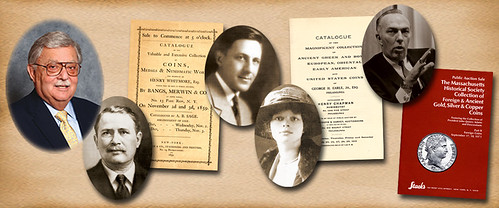
PREV ARTICLE
NEXT ARTICLE
FULL ISSUE
PREV FULL ISSUE
HARVEY STACK ON NUMISMATIC PEDIGREESIn his recent blog posts, Harvey Stack discussed
the value of numismatic pedigrees. Here are some excerpts.
-Editor
 One of the many questions I am asked is: "Why is having the pedigree of rare coins and currency you sell important?" The pedigrees of numismatic items, works of art, jewelry, or other collectibles are valuable assets. They can record ownership from the day an item was issued or first sold and contain a history of subsequent owners. Most old-time collectors retained pedigrees, as they have been important to buyers through the decades. They are still important, right up to the present day, and the retention of pedigrees into the future will continue to add value to a numismatic item. Collections in America, as well as the rest of the world, were mostly assembled by those who could afford to put items away and save them for the future. When we examine the early days of America and into the Industrial Revolution, collectors had many handicaps that do not exist today. There was little if anything published that collectors could refer to, and they were lucky to have access to any information on coinage and coinage history. Dealers of course experienced the same restrictions. Dealerships were located only in a few major cities or near them, auctions were few, and price lists were originally handwritten to the client, or in rare cases distributed to only a few. After the Civil War, some things changed. People earned a bit more, more wealth was accumulated, and important dealers in numismatics opened shops in Philadelphia, New York and Boston. These shops attracted mostly local collectors. Auction sales became more prevalent and a few lists of coins were distributed. Many of these publications listed the famous collectors who had these coins for sale, and often previous owners were listed in the catalogs. The dealers felt that showing a pedigree established the worthiness of the coin, especially if the previous collector was known to be well educated in the fields he collected. A pedigree to an astute collector could show how a coin rated. Before the late 20th century there were no grading services or encasement in sealed plastic holders. Today when a coin is graded it often has, if available, the latest pedigree of the coin printed on the holder. Years back when we did not have encapsulation of coins in "slabs" (the common word to describe the encased coins today), the owner of a coin often relied on the pedigree printed or written on a coin envelope (usually 2 x 2 inches), and that envelope was kept with the coin as it traveled from one collection to another. Earlier or when envelopes were not available, the owner or cataloger might try to match the coin to one in an earlier catalog, if it had a photograph or a distinct mark or impairment that could be described and readily identified. Though these methods were not foolproof, for many coins they helped answer important questions: Who owed this coin before? Was he or she a famous person? Was this from some earlier, almost complete collection? Collectors became excited about a coin’s pedigree as well as its rarity, price and other features. The coin’s history became important and dealers, when describing a coin for auction or a price list, would research earlier pedigrees. Dealers like Stack's Bowers research all coins they can for earlier pedigrees. The lots sold by auction usually have an envelope or tag identifying the sale they are being sold in, along with their lot number, so the pedigree is sustained for the future. In this way the value of a coin’s past can be maintained, as long as the information is kept intact. To read the complete articles, see:
Wayne Homren, Editor The Numismatic Bibliomania Society is a non-profit organization promoting numismatic literature. See our web site at coinbooks.org. To submit items for publication in The E-Sylum, write to the Editor at this address: whomren@gmail.com To subscribe go to: https://my.binhost.com/lists/listinfo/esylum All Rights Reserved. NBS Home Page Contact the NBS webmaster 
|